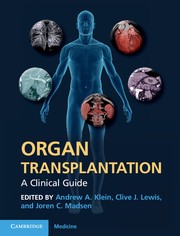Crossref Citations
This Book has been
cited by the following publications. This list is generated based on data provided by Crossref.
Frei, Anthony W.
and
Stabler, Cherie L.
2014.
Bio‐inspired Materials for Biomedical Engineering.
p.
327.
West, James M.
2018.
Ethics of Liver Transplantation: The Role of the Anesthesiologist.
Seminars in Cardiothoracic and Vascular Anesthesia,
Vol. 22,
Issue. 2,
p.
229.
Gillespie, Mark
and
Rizzolo, Denise
2018.
A systems-based approach to patient care after liver transplantation.
JAAPA,
Vol. 31,
Issue. 1,
p.
14.
Hossain, Mohammad Ayaz
Chadha, Radhika
Bagul, Atul
and
Motallebzadeh, Reza
2019.
Procurement and Transplantation of Abdominal Organs in Clinical Practice.
p.
69.
Chang, Sung-Ho
Kim, Hyun Je
and
Park, Chung-Gyu
2020.
Allogeneic ADSCs Induce the Production of Alloreactive Memory-CD8 T Cells through HLA-ABC Antigens.
Cells,
Vol. 9,
Issue. 5,
p.
1246.
Steitz, Marvin
Zouhair, Sabra
Khan, Mahamuda Badhon
Breitenstein-Attach, Alexander
Fritsch, Katharina
Tuladhar, Sugat Ratna
Wulsten, Dag
Wolkers, Willem-Frederik
Sun, Xiaolin
Hao, Yimeng
Emeis, Jasper
Lange, Hans-E.
Berger, Felix
and
Schmitt, Boris
2023.
A Glutaraldehyde-Free Crosslinking Method for the Treatment of Collagen-Based Biomaterials for Clinical Application.
Bioengineering,
Vol. 10,
Issue. 11,
p.
1247.



